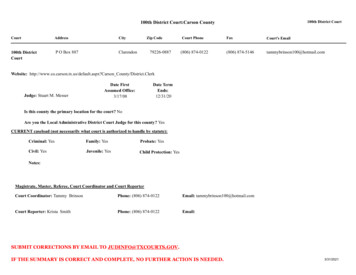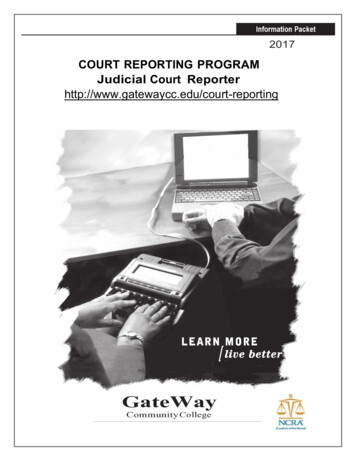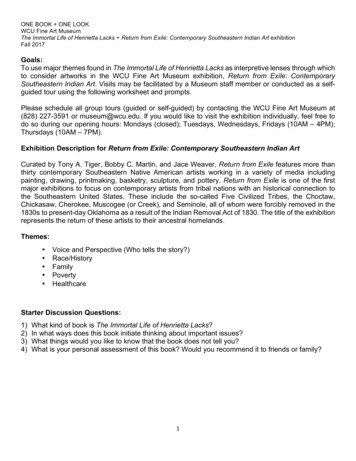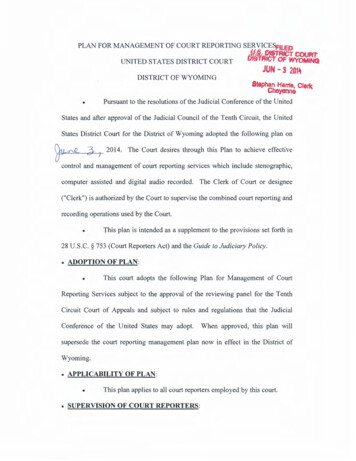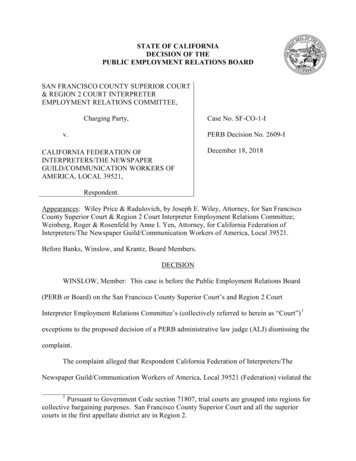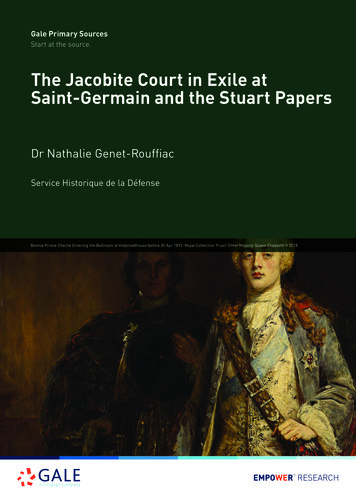
Transcription
Gale Primary SourcesStart at the source.The Jacobite Court in Exile atSaint-Germain and the Stuart PapersDr Nathalie Genet-RouffiacService Historique de la DéfenseBonnie Prince Charlie Entering the Ballroom at Holyroodhouse before 30 Apr 1892. Royal Collection Trust/ Her Majesty Queen Elizabeth II 2018EMPOWER RESEARCH
By the beginning of 1689, James II and VII and hisFebruary 1702 by Richard Baggot . Until 1715, however,queen, Mary of Modena, had fled to France where Louismost of the new office-holders were sons andXIV put at their disposal the castle of Saint-Germain-daughters of the first generation of the exiled courtiers,en-Laye, near Versailles. Both kings had spent part ofnot newcomers. The court in exile at Saint-Germaintheir youth there and they shared common memories ofbecame less and less representative of the political andthe Stuarts' first exile (1648-60). After his defeat insocial realities of the British Isles, a phenomenon thatIreland, James II and VII definitively retired to Saint-eventually weakened the ability of the exiles at Saint-Germain, where he died in 1701. In 1713, anticipatingGermain to understand British political life.[5]the conclusion of the treaty of Utrecht, his son James[1]'III and VIII' moved his court from France to Lorraine,then Avignon and eventually to its last destination,Besides individual warrants, several lists of themembers of the royal Households have been preservedfor the 1693-1705 period, as well as lists of pensions.Rome.Three of them are part of the Stuart Papers: a list ofThe Jacobite court at Saint-Germainsalaries and pensions paid by Mary of Modena, 'for the3 last months of the year 1693' , a compilation of the[6]Drawn by the royal family, Jacobites in exile gathered atand around the court of Saint-Germain. The waves ofarrivals and the network of royal favour can be tracedthrough the appointments of office holders at the court.Most of them were registered in the Livre royal desEntrées et des Brevets and they were published in 1904[2]in The Jacobite Peerage by Melville Massue de Ruvigny,Marquis de Ruvigny and Raineval . Some of the office[3]holders, such as William Waldegrave, who had attendedMary of Modena at the birth of James Edward and wasappointed first physician to the King on 23 May/2 June1695, followed their sovereigns in exile from the time ofthe Glorious Revolution. Others were personal friends,such as Bridget Mannock, who was very close to QueenMary . As long as the Jacobite court stayed at Saint[4]Germain, new appointments were regularly made andthey remained a powerful political tool for the king in137 appointments for the four services of the court (theKing's, Queen's and Princess's households and theStables) from October 1701 to July 1702 and a list of[7]the members of the Queen's household in 1703 . They[8]are complemented by a list of the inhabitants of thecastle of Saint-Germain drawn up before October 1692and preserved in the Nairne papers at the BodleianLibrary, Oxford , an inventory of the wages and salaries[9]paid by the King and the Queen during the summer of1696, now preserved at Sizergh castle , and a list of the[10]monthly wages and pensions of the whole royalHousehold for January 1709 in the British Library .[11]Finally, a list of James II and VII's household wasprocured by Charles Montagu, Earl of Manchester andWilliam III and II's envoy at Paris between 1699 and1701; it is part of the earl's papers, now at the BeineckeLibrary, Yale .[12]exile, enabling him to attract, reward and encouragethe exiled Jacobites. As time went on the offices in theIn the 1690s, the Jacobite court at Saint-Germainroyal households passed on to a new generation. Thus,appears to have been a kind of smaller version of thein July 1701, Colonel Henry Slingsby died and wascourt James II and VII had known at Whitehall. The sizesucceeded as gentleman of the Bed Chamber on 1/12of the King's household at Saint-German can be
estimated at around 90 people during James's lifetimeThe great majority of the courtiers were Catholics, butand around 130 during his son's time there. Thethere were also Protestants at the Jacobite court,Queen's household never exceeded 100 before 1690,particularly Nonjurors, and some of these were notablyand decreased to 90 later on. This means that theimportant. Denis Granville, Dean of Durham andwhole royal entourage never amounted to more thanbrother of the Earl of Bath, for example, received a200 people. But the courtiers in positions that carriedcertificate on 17/28 August 1695, stating that he waspolitical influence or held an office close to the royalone of those loyalists, 'resisting the evil example offamily only numbered around 50, whereas the court atthose of the Church of England who countenanced theWhitehall before the Glorious Revolution had employedhorrid invasion of 1688 and having quitted all that hemore than 600. The size of the household of James IIhad follow the King in France' . Though Granville wasand VII at Saint- Germain was, in fact, no bigger thanonly a part-time resident at the court, where he hadthe one he had kept as Duke of York before 1685. Tobeen appointed chaplain, James II and VII protested hedraw a comparison with Versailles, thewas the best friend he ever had, and Granville referred6000 livres yearly pension Lords Herbert, Middleton andto James and Queen Mary as, 'my father and mother',Caryll were granted in June 1700 would have been theand James 'III and VIII' as 'my brother'. In 1699, in aequivalent of the wages of Louis XIV's premier valet decodicil to the King's will, he was nominated to thechambre at Versailles and the yearly pension of aQueen's council . He remained with James II and VIIsecretary of state of the Sun King amounted to 20,000throughout his final agony almost till his end and Queenlivres. In 1703 Mary Gordon, Duchess of Perth, enjoyedMary made him a member of her Household in 1702. Hea monthly salary of 314 livres, 8 deniers, and 4 sous , atdied the following year. His three nephews George,a time when Louis XIV's ordinary valets deThomas (secretary to the Queen then Secretary of Statechambre received 500 livres.to James 'III and VIII' in Lorraine), and Bevill Higgons[15][16][13](the poet) were active Jacobites. All three of them wereFrom the 1701-1702 list of appointments, it is clear thatProtestants.a range of different national groups were employed atthe court. The English composed 45%, the Irish 39%,From 1689, Louis XIV granted his cousin a yearlythe Scots no more than 3%. There were also Italianspension which continued until his own death in 1715.(6%), employed by the Queen, and a small group ofThe money was intended to pay the wages of theFrench (7%) who had followed the Stuarts since thecourtiers, but also to support the thousands ofRestoration and who mostly worked in the royalJacobites who gathered around the king they hadkitchen, such as François Gauthier, 'gentleman of thefollowed into exile. When he came back from Ireland,Buttery and yeoman of the Chaundry' . The percentageJames II and VII had to prepare for a longer exile thanwas, furthermore, very different in each part of thehe had expected and, 'began to think of settling himselfcourt. The King's household was predominantly Englishat Saint-Germains, and of modelling his family and way(67.5%) while 56% of the staff of the Stables were Irish.of living suitable to the pension of 600 000 livres a year,[14]which he received from the court of France' . Already[17]
straitened, the situation grew critical after the treaty ofthe British Isles through regular correspondence withRyswick in 1697 and the disbanding of one third of thefriends of the cause was one of the main duties of the'Wild Geese' . Orphans and widows of Irish soldiersSecretary of State, a task John Drummond, Jacobitewere almost totally dependent on the charity of theDuke of Melfort, and James Drummond, Jacobite Dukecourt for their survival, in spite of some supportof Perth, bitterly contested with Charles Middleton, Earlprovided by sympathetic French sources. On 13/23of Middleton. A small number of agents were directlyOctober 1699, Mary of Modena sent a grateful letter topaid by Saint-Germain and their names can be found inthe prior of Saint-Germain- des-Prés in Paris, who hadthe cyphers of the court . Three are known to havetold her of his desire, 'to give a pension of 150 livres forbeen active between 1710 and 1714: James St Amandthe relief of the King's poor subjects' . The Stuart(1643-1728) in England, John Menzies, alias 'Abraham',Papers show how critical the financial issue was foramong the M.P.s and peers at Westminster and HenrySaint- Germain and the amount of time and energy itStraton, alias 'Scougal', in Scotland .[18][19][20][24][25]required from the Queen to deal with it. The list ofpensions already mentioned of February 1703 wasYet the court was not only a political centre. It alsostood at the centre of a royal administration, even ifdrawn up in order to cut the court's expenses:'Whereas our disbursements exceed our receipts near4000 livres per month, that we may not run in debt, orsuffer those to perish who live by our pensions, we, asguardian of our son, by the advice of his Privy Council,hereby order you to make payment of the pensionsusually paid by you accordingly as you will find themreduced in the lists of pension signed by us for Januarylast, till further order' . Likewise, in 1708 she wrote to[21]her Treasurer, William Dicconson, that she may be,'forced to sell the rest of the jewels' . In 1715 again,[22]she asked Dicconson to write to the son of the greatJacobite banker Sir Daniel Arthur to find means to payPiers Butler, Earl of Newcastle, the four months ofwages he was due: 'I beleeve if you answer for it to MrArthur, he will do it for him on my account, but praydon't lett anybody know the contents of this note' .Saint- Germain offices appeared to be mere 'amateurs'by comparison with those of Louis XIV's absolutistbureaucracy. Maintaining a working relationship withthe French authorities was thus a regular duty forJacobite Secretaries of State. The Stuart Papersprovide many examples of the variety of certificatesthat had to be provided to satisfy French administratorswho were unsure how to deal with troublesomeJacobite exiles. The French foreign minister JeanBaptiste Colbert de Croissy, Marquis de Torcy, forexample, demanded that all newcomers makethemselves known at Saint-Germain, where they wouldbe issued a certificate of good behaviour. On 26 May/6June 1705, even Sir Richard Bulstrode had to ask forone on his arrival in Paris, though he had been:[23]The court of Saint-Germain as a Jacobite'.for many years English Envoy at Brussels and continuedthere after the usurpation till 1694, doing all the serviceshe could to France, by correspondences he carried on withadministration Saint-Germain was the centre offrontier towns in the conquered countries. His givingJacobite intrigues, at least until James 'III and VIII' leftintelligence being at last discovered, he was obliged to flyfor Lorraine in 1713. Keeping alive Jacobite networks inprecipitately to France, leaving his family at Brussels,
where they were insulted and all the furniture and effectsconfiscated.'[26]'Wild Geese' followed Patrick Sarsfield to France afterLimerick's capitulation, the new regiments wereNaturalised foreigners were also submitted toregulations in France that Saint-Germain tried both toease and to apply. When Lewis Innes, one of threebrothers involved in running the Scots College, leftParis to join James 'III and VIII' in Lorraine in 1713, hehad to obtain permission from Torcy. According toJames Fitzjames, Duke of Berwick, 'it was fitting heshould, for he is naturalized, and consequently cannotstirr out of France without leave' . The reliability of[27]interpreters was often suspect and Middleton had togive a certificate to Patrick Hicky, an Irish interpreter atthe court of Chatelet, stating that he had come toFrance after the defeat of Limerick, was a good subjectof the King and was lodged at, 'rue Sainte-Marguerite,Faubourg Saint-Germain' . In the same way, Jacobites[28]had to obtain genealogical certificates from James Tiry,herald of arms of the Jacobite court, before they couldask for a Letter of Nobility from the French authorities,as was the case on 23 December 1699/2 January 1700with Luke Commerford, one of the 'Commerfords ofWaterford' who were fighting in the ranks of the 'WildGeese' regiments in France and in Spain .instituted on a totally different basis. An agreement wassigned between the two kings stating that the new Irishregiments, though at the disposal of Louis XIV,remained James's troops. It was an unprecedentedconcession and proof of Louis XIV's commitment to hiscousin's cause that he allowed a kind of foreign armyon his kingdom's soil. Consequently, it was James whosigned the warrant organizing the Jacobite troops intotwo Horse Guards regiments, two Cavalry regiments,two Dragoon regiments, eight Infantry regiments andthree independent companies . The officers'[31]commissions were issued by James (except for thehighest ranks, which Louis kept in his own gift). Onlythe soldiers' wages were paid by Louis XIV. As foreigntroops, they should have received higher wages thanthe French, but Louis XIV insisted that they would bepaid on the same footing as French soldiers and soJames II and VII compensated them by pledging that hehimself would pay them the difference as soon as hewas back on his throne . These wages were then[32]doubled when the troops were in winter quarters .[33][29]The main role of Saint-Germain, as a Jacobiteadministration, was dealing with the 'Wild Geese'. On21 April/1 May 1689 Louis XIV demanded a Jacobitecontingent be sent to join his armies on the continent tooffset the French troops he was sending to help hiscousin in Ireland. An Irish Brigade was accordinglyintegrated into the French army under the command ofJustin MacCarthy, Viscount Mountcashel . As Irish[30]regiments of the French army, they were granted thestatus of foreign troops and soldiers and paidaccordingly. By contrast, when the main body of theThe routine administration of the 'Wild Geese' wasthereafter done by Saint-Germain, where Sir RichardNagle, Secretary of State for Ireland, was put in chargeof the correspondence with the officers and handled themany details of sustaining the 14,000 Irish troops inFrance. He remained Minister for War until his death inApril 1699. After the treaty of Ryswick in 1697, one thirdof the regiments had to be disbanded. Many ex-soldiersgathered around Saint-Germain where they hoped to besustained, or decided to move to western France wheremany Irish merchants had already settled. BryanMacDermot, for example, merchant at Rouen in 1710,
applied for the favour of James 'III and VIII' on the'.commission to command the Spy and to take, or in caseof resistance destroy, all ships with the goods and lading,grounds that:belonging to the inhabitants of England, Scotland and'he had served the late King during the Irish Wars as a footcaptain, and . after the capitulation of Limerick, he left hisproperty and country to follow his said Majesty to France,and served there as an officer the whole of the last war,only quitting the service when the troops were reformed atIreland, with the ships and goods of any of the enemies ofthe King or the Most Christian King [Louis XIV], and to bringall such ships and goods without breaking bulk into someFrench port, and procure the same to be judged in the nextcourt of Admiralty established by the most Christian King,paying the tenths belonging to the King to his agent.'[39]the peace of Ryswick, after which he was obliged to trade toendeavour to maintain himself, while his four brothers whocrossed to France with him continued to serve as officersand have all died during the present war.'[34]The rest of the text outlined the instructions, 'to beobserved by such as shall arm any ships in course' andsimply translated the official French instructions. OnThe officers' attachment to the court at Saint Germainremained very strong: most took up winter quartersthere and sometimes they or their relatives held officein one of the royal households. Sarsfield's widow,Honora Bourke, daughter of John Bourke, Earl ofClanricarde, eventually married Berwick in 1695 andhis son was granted a pension in 1698 .[35]Saint-Germain was also initially in charge ofsupervising the Irish privateers operating from westernFrance. As early as 1692, James II and VII appointedThomas Strafford receiver of the king's tenth of theprizes for Brest and Brittany, but Sir William Ellis hadto be named in August 1695 to try to put some order inStrafford's accounts. It turned out he owed the Kingmore than 14,000 livres, but James forgave him out of,'compassion on his indigent condition', and releasedhim from his duty . In 1692, the first letters[36]marque were registered by James Nihill, agent to the[37]Commissioners for the Revenue . Nine ships were[38]already at sea and a total of thirteen letters of marquewere granted, but from 1693 the French resumedcontrol of such certification. Thus in 1694, most likely inNovember, Edmond Finch received a:the list of officers, a privateer named Peter Nagle waskilled at sea in 1695. He had been commissioned byJames II and VII on 13/23 February 1695 to commandthe Marin on the same day Philippe Welsh wasentrusted with the Trompeuse . Both were based at[40]Brest. Nonetheless, when Madagascar privateersstarted to look for the official protection of a prince in1706, they applied to James 'III and VIII', offering '800experienced sailors [who] could serve on board of shipsof the King'.At a more general level, the role and the organization ofthe court of Saint-Germain as an ally of France is one ofthe many fields of historical research that need to befurther explored through the records left by the exilesand now accessible among the Stuart Papers atWindsor.
NOTESSigned in 1713 to establish the peace at the end of the War of theSpanish Succession (1701-1714), the treaty recognised Philip V asKing of Spain whilst requiring him to renounce his claims to theFrench throne.[1][2][20]HMC Stuart, i. 143; RA SP/M/15/229.[21]HMC Stuart, i. 180; RA SP/M/19/15.[22]HMC Stuart, i. 228, RA SP/Main/2/50.[23]HMC Stuart, i. 441; RA SP/Main/5/50.[24]RA SP/Box/5.[25]HMC Stuart, i. 507, 508; RA SP/Main/6/25.[26]HMC Stuart, i. 202; RA SP/Main/2/34.RA SP/M/18.[Melville Amadeus Henry Douglas Heddle de la Caillemotte deMassue de Ruvigny], Marquis de, The Jacobite Peerage, Baronetage,Knightage and Grants of Honour (London, 1904).[3]F. H. Blackburne Daniell (ed.), Calendar of the Stuart Papersbelonging to His Majesty the King, preserved at Windsor Castle, Vol. 1:1579-Feb 1716. (Historical Manuscripts Commission, 1902), 103, 164.[4][5]HMC Stuart, i. 171; RA SP/M/19/63.[27]HMC Stuart, i. 258; RA SP/Main/2/86.[6]RA SP/Main/1/79.[28]HMC Stuart, i. 151; RA SP/M/18/135.[7]HMC Stuart, i. 162; RA SP/M/19/45. Also, HMC Stuart, i. 163-176.[29]HMC Stuart, i. 145; RA SP/M/18/177.[8]RA SP/Main/2/23.[30]HMC Stuart, i. 41; RA SP/M/18/11.[31]HMC Stuart, i. 6; RA SP/M/18/31.[32]HMC Stuart, i. 67; RA SP/Main/1/67.[33]HMC Stuart, i. 83; RA SP/M/18/49.[34]HMC Stuart, i. 238-9; RA SP/M/19/89.[35]HMC Stuart, i. 134; RA SP/M/18/127.[36]HMC Stuart, i. 69, 105, 122; RA SP/M/18/35, 101, 113.Bodleian Library, Nairne Papers, Carte MSS 180-181, 208-212, 256258.[9][10]Strickland Collection (R4) at Sizergh Castle, Cumbria.[11]British Library, Egerton MS 2517.Manchester Papers. James Marshall and Marie-Louise OsbornCollection, Beinecke Rare Book and Manuscript Library, YaleUniversity.[12][13]RA SP/Main/2/23.[14]HMC Stuart, i. 164; RA SP/M/19/55.[15]HMC Stuart, i. 106; RA SP/M/18/99.[38]HMC Stuart, i. 69; RA SP/M/18/35.RA SP/Main/1/114.[39]HMC Stuart, i. 92-3; RA SP/M/18/85.[40]HMC Stuart, i. 97; RA SP/M/18/89.Letter giving the bearer licence to fit out an armed vessel and use itin the capture of enemy merchant shipping.[37][16]J. S. Clarke (ed.), The Life of James the Second, King of England, &c,Collected out of Memoirs Writ of His Own Hand (2 vols, London, 1816), ii.472.[17]The concluding treaty of the Nine Years' War, or the War of theLeague of Augsburg (1688-1697), which France and her Jacobiteallies lost to the Grand Alliance of the Dutch Republic, England,Scotland, the Holy Roman Empire, Spain, Savoy and Sweden. Amongother articles, Louis XIV was compelled to recognise the outcome of1688 and to acknowledge William of Orange as King of England,Scotland and Ireland, thereafter giving very limited assistance to theexiled James II.[18]Irish soldiers who left Ireland for France after the surrender of theJacobite forces at the treaty of Limerick on 3 October 1691, in a massexodus known as 'the Flight of the Wild Geese'.[19]
CITATIONGenet-Rouffiac, Nathalie: “The Jacobite Court in Exile at Saint-Germain and theStuart Papers.” State Papers Online: The Stuart and Cumberland Papers from theRoyal Archives, Windsor Castle, Cengage Learning (EMEA) Ltd, 2018 Cengage Learning 2018@GaleEMEA
the prior of Saint-Germain- des-Prés in Paris, who had told her of his desire, 'to give a pension of 150 livres for the relief of the King's poor subjects'[20]. The Stuart Papers show how critical the financial issue was for Saint- Germain and the amount of time and energy it required from the Queen to deal with it. The list of




